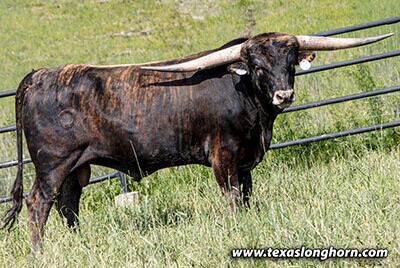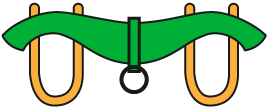TLH - Newsletter (englisch)
Used courtesy of Dickinson Cattle Co. USA

Selecting The Right Bull
Erstellt am: von Longhorn
DCC Ranch e-News #281 - 7-11-22
by Darol Dickinson
The old story is told of a fellow from Rhode Island who went to Texas and saw his first Texas Longhorn cattle. He got real excited and quickly started a plan by purchasing 40 acres of land in Rhode Island and stocking 40 cows and 40 bulls. Although this fellow, in his haste, had a poor business plan, many today adapt parts of this same plan. The results are seldom good--but it doesn't have to be this way.
Although 40 bulls for 40 cows is somewhat of an over-kill, one very well-planned bull for the cow herd is a good thing. But his first question should have been, “What is my target?” He should have had a better plan. Some wanna-be ranchers say they are not in the Texas Longhorn industry as a business. It’s a hobby. In that case, the bar is lowered way down close to the ground and the target will be easy to hit.
Sometimes it appears the smaller the horns the better. Very small horned cattle are economical. The purchase price is low. That is one way to go. On the other hand, if you want to show in the TLBAA circuit, big horn is not necessary, yet you will need very fat-thick, early gaining cattle to win.
If the target is high-value cattle, think hard about a profitable plan. The widest horn spreads can't be ignored. Check the Arrow Head Cattle Company (http://www.arrowheadcattlecompany.com) and identify the largest-horned sires. They will take a herd into the high horn-dollar direction. Horn sells better than hamburger. In this business you are known by the quality of your best bull, and to be high value they must have wide horn.
Some producers are very interested in the lean beef industry. That’s where Texas Longhorns are the healthy-food king. Check out which sires make a ton or better at maturity and point the herd toward that target. If cows weigh in the 700-lb. range and bulls in the 1100-lb. range, you can't afford enough corn to be successful in the meat industry. In a lean-meat plan, there is no such thing as good little cattle or bad big ones. When using 700 lb. cows and 1100 lb. bulls the feeder steers will grow slowly into a 950 to 1000 weight then shut down to a very slow growth -- totally unprofitable.

Another target is showing in ITLA and the high-dollar futurities. In ITLA competition, show cattle with small horns or horns that point forward are considered defective or cross-bred, and will not win. Cattle that are all horn and no beef are also unlikely to win. The futurities and ITLA shows award big prizes to the total animal with color, correct breed standards, body thickness, plus horn -- the right length and shape.
Now back to selecting a bull to take the herd to the target. Most Texas Longhorn producers own 3 to 10 cattle. Some have 40 cows. Only a few have more. Each herd size has different considerations for a herd sire.
Six-cow herd: It is not wise to invest in a $10,000 bull for only a few cows. First consider the budget. If in fact, the six cows are $20,000 cows, they should be bred to one of the top sires in the industry. If they are $800 cows, a much-less-valuable bull could do the job. Many people want to lease or borrow a bull – but this cost-saving measure often has its problems. If the borrowed bull comes from a herd with some reproduction disease, then the new economy-model sire has contaminated all six cows. Some producers will keep the nicest bull from their own calf crop to save money--and then realize his dam and sisters are going to be bred to him. This is not a good production plan. An unrelated very good bull that is within the budget is a good choice.
Forty-cow herd: With this size herd, a very good bull is important--possibly one that is far superior to any of the cows. Now the budget that wasn't suitable for six cows is a real consideration for the forty-cow herd. To increase progeny values an outstanding bull is very
necessary. The bull used will affect the value of every calf, up or down.
Artificial Insemination: No matter what size cow herd, no bull is an exact fit for every cow. This diversity dictates cherry-picking special AI sires to carefully mate to select cows. A good marketing plan includes calves sired by more than one bull. Variety helps to sell a breeding group with an unrelated bull and heifers as a package. AI is a way to raise the quality of the herd without buying a $50,000 bull.
Semen selection: If thick cattle with good gain are important, 22 sires are available that weigh over a ton. If horn is important, more than 50 bulls are available that measure more than 90" tip to tip. Big horn is everywhere and is the easiest virtue to quickly achieve. But big horn isn’t everything. Value-color and beef quality are important considerations. Adding more factors to the genetics reduces the number of those 50 bulls way down. For instance at the Horn Showcase, bulls age 3 and over weighed as little 1105 lbs. and as much as 2186 lbs. That is 1081 lbs. difference. The smaller bulls will most likely sire mature cows weighing about 700 lbs., while the larger bulls will sire cows around 1100 to 1200 lbs. For feeder calf evaluation, the 700 lb. cow will produce steers that grow under one pound on feed per day, and the ton bulls, when bred to larger sized cows will produce steers with gain averaging about 3 lbs. per day.
Raising correct calves takes a long time. When a cow herd is extremely small or has conformation defects, even breeding to the strongest sires to correct those traits may take two or three generations. Don’t assume one great bull will automatically correct everything, every time.
Sire Selection: Know what the sire weighs when purchasing semen. If he has a good weight, normally the owner will advertise it. Know what the bull officially measures tip-to-tip, and at what age. If the owner says he has never weighed his bull but he has been told about a ton --- that normally means 1105 lbs. If sire owners are selling high-dollar semen, there is no valid excuse for not knowing current tip-to-tip and weight. Withholding those measurements is very unprofessional, or else deceptional.
Sexed semen: Sexed semen is very popular, but pricey. Normally, female sexed semen is about 3 times higher-priced than conventional semen. If the cow is good enough to be the dam of a herd sire herself, don't use sexed semen. Go for good bull progeny value. Shop the market. Some semen is very over-priced and some is competitive. Consistent proven sires of high-dollar progeny have a right to charge a lot more for semen than a young unproven bull.

Breeding for color: When desiring specific colors it is not easy, but success can happen. If a lot of cows are light-pale colors use a black, or homozygous black bull to move up to more value-dark colors. If cows are mostly white use a bull with very little white color and hope to achieve a spot pattern of about half white and half dark. If a cow has a lot of white on her face, appearing like a Hereford, always breed her to a bull with no white on the face. This is where AI can make it easy to plan for every mating.
Measuring value: Semen from mature bulls with under 75" tip-to-tip should sell economical, like $10 to $35. Bulls over 80" could be $35 to $60. Bulls over 90" can be $100 or more depending on other value traits including weight and attractive color. Shop the market. In the ’sixties as the breed was starting, the average tip-to-tip on bulls was around 32". Even today, however, some AI-enrolled bulls measure even less and are very over-priced. Some bulls have large hind quarters and no horn, while some have wide horn and no rear end. Remember that the best bulls are big on both ends and long in the middle.
Culling the herd: Regardless of the time and effort selecting a young sire or semen, some cattle will fall well below expectations. Have a plan. Never sell at a local livestock auction. That is a liquidation, wholesale market. Live cattle prices are low, but beef is now at the highest price in the history of the world. Find a good processing plant, make lean Texas Longhorn grind, and sell at the top of the market with a smile. In this business you can't lose -- unless you work hard at losing.
Republished from ITLA Drover
Dickinson Cattle Co., Inc.; 35000 Muskrat Rd.; Barnesville, OH 43713; 740 758-5050
